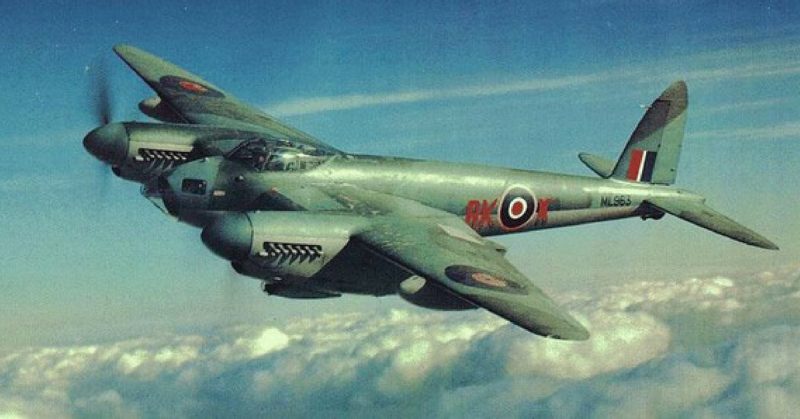A British Plane
The de Havilland Mosquito was a British aircraft that served in a wide variety of different roles during WWII.
The Wooden Wonder
The Mosquito was made almost entirely from wood. In an age of metal planes, it was a deliberate choice. Building a Mosquito used fewer resources such as aluminum than other planes being produced. As supplies became short, it made it a very efficient tool of war. It was known as the “Wooden Wonder.”
Designed to Not Need Defences
The Mosquito’s design was also innovative in other ways.
It was originally designed in 1938 as a bomber and reconnaissance plane. Rather than having defensive armaments, as most planes did, it was able to fly high and fast so that enemy planes could not reach it. Avoiding a fight was the Mosquito’s defense.
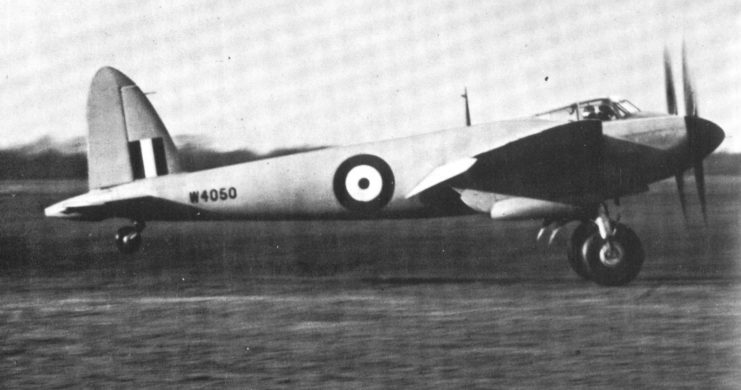
Overcoming Doubts
The British Air Ministry had doubts about the strangely designed plane. It took some time to persuade them of its potential. It was not until November 1940, over a year into WWII, that the first Mosquito flew, convincing doubters it was a worthwhile investment.
Priority Production
Having approved the Mosquito for production, the Ministry prioritized building the bomber version. The air war had already turned into a battle of attrition, with both sides pounding each other’s cities from the air. A cost-effective and survivable bomber would be an invaluable asset for Bomber Command.
Other Early Prototypes
As the bomber went into production, prototypes of two other versions – a fighter and a photo-reconnaissance plane – were ordered.
Becoming a Night Fighter
The first Mosquito fighter flew in May 1941. Once again, the Mosquito’s performance won official approval. It was immediately developed into a night fighter to defend the skies above Britain from Luftwaffe attacks. It was equipped with Airborne Intercept (AI) radar, a new and secret form of technology.
After entering service in January 1942, the Mosquito NF.II quickly became the RAF’s standard night fighter in Britain, replacing the Bristol Beaufighter.
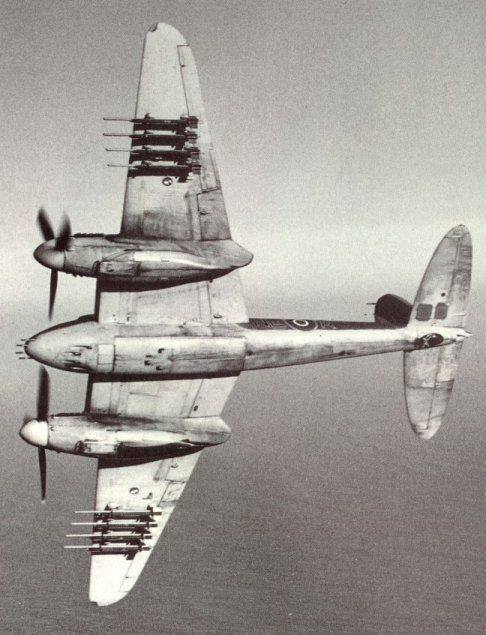
A Potent Fighter-Bomber
At the end of 1942, Mosquitos were deployed to Malta, entering the Mediterranean theater of the war. There, they fulfilled two roles.
On the one hand, Mosquitos still acted as night fighters, protecting Allied forces from Axis attacks.
They also went on aggressive missions during the day. In Italy, Sicily, and North Africa, Mosquitos used their capabilities as fighter-bombers to destroy enemy trains, disrupting their transport, supply and communication networks.
Giving Up on the Day Fighter
At one point, designers were working on a version of the Mosquito that would have been a straightforward daytime fighter plane. However, the fighter-bomber and night fighter versions were so effective the fighter option was dropped, and the specialist planes continued to be produced.
Updating the Night Fighter
The night fighting mosquito went through several updates and adaptations during the war. Its radar was improved as technology developed. Nose-mounted machine-guns were abandoned. Instead, four cannons, which gave greater punch against planes with armored fuselages and self-sealing fuel tanks, were added.
As a result, the Mosquito NF.II was replaced by the NF.XII, the NF.XIII, and finally the NF.XVII.
Tail Radar
Some Mosquito NF.XVIIs were equipped with a second set of radar equipment in their tails. It warned them of planes targeting them, allowing them to avoid becoming prey to enemy fighters.
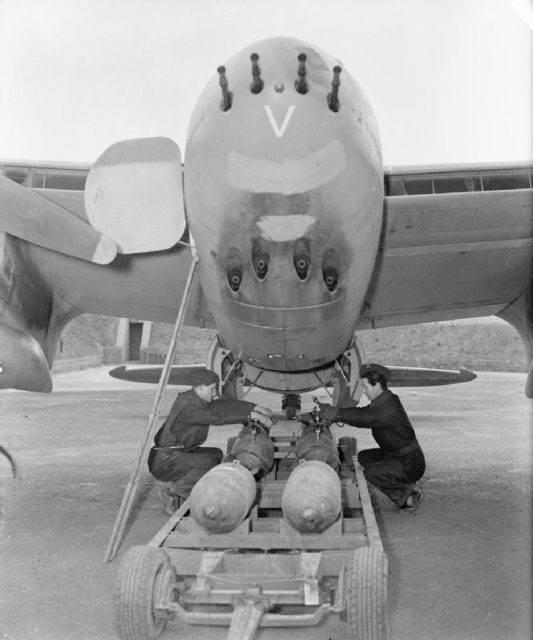
Fighter-Bombers Win Through
The fighter-bomber Mosquitos were among the most popular in this line of planes, with the FB.Mk VI used more widely than any of the other Mosquito fighters. Highly effective as both a day and night fighter, it eventually carried two 500 pound bombs as well as the forward guns of a fighter plane.
A Rocket-Armed Fighter
Coastal Command, the part of the RAF responsible for defending Britain’s coastal waters, created a new variation of the FB.Mk VI. It was equipped with rockets, a type of weapon coming into its own at the end of the war. It became a powerful maritime strike plane.
A Rocket-Stopping Fighter
From June 1944, Germany began launching rockets at Britain from mainland Europe. V-1 flying bombs struck terror in British cities with their sudden and unexpected arrival.
Mosquito VIs were able to intercept the missiles as they headed for their targets. On the night of June 14, Flight Lieutenant J. G. Musgrove was the first pilot to intercept a V-1 using a Mosquito. Other pilots soon followed his example. A total of 428 V-1s were shot down by Mosquitos during the months of the German rocket attacks.
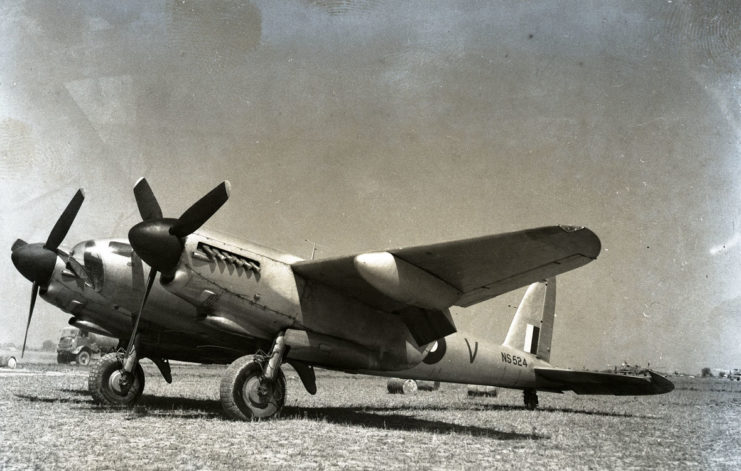
The Sea Mosquito
In 1944, trials of Mosquitos as shipboard planes took place on board the HMS Indefatigable. In March, a Mosquito was the first British twin-engine plane to land on an aircraft carrier successfully.
It led to the development of the Sea Mosquito. It had an altered undercarriage and folding wings to make it suitable for service. The plane was not in production in time for the war, but it did see service. In 1946, the Sea Mosquito joined the Royal Navy.
The NF.30
The NF.30 was the ultimate wartime Mosquito night fighter. It escorted RAF bombers on missions to Germany, destroying German fighters that tried to intercept the attacks.
Post-War Career
The Mosquito continued to be used after the war. The NF.36, equipped with new American radar, was exported to Yugoslavia where rebuilding was being undertaken after the German occupation. In Britain, Mosquitos continued flying until the early 1950s. In the age of the jet plane, it began to look dated, but post-war Britain was too busy recovering to worry about the technology gap.
Source:
Francis Crosby (2010), The Complete Guide to Fighters & Bombers of the World
